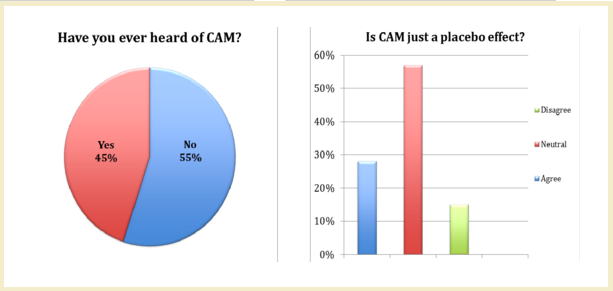Title
Medical student Perception and Attitudes toward complementary and alternative medicine in Saudi Arabia
Background
Complementary and alternative medicine (CAM) is a group of medical and health care interventions, practices and products that are not usually considered as part of conventional medicine.
- Statistics in the US show that out of 117 medical schools, 75 (64%) offered either elective courses in CAM or include these topics in required courses.
- In contrast only 11 out of 90 medical (12.2%) colleges in KSA offer CAM courses in their curricula and fifteen colleges teach topics related to CAM in different courses.
Local as well as western studies have shown that the usage of complementary therapies was highly prevalent among patients suffering from cancer and other chronic diseases. Due to fact Saudi Arabia is well-known for the prevalence of chronic diseases among its people; it would be of great benefit to elaborate on the perception and attitude of our medical students towards CAM.
Summary of Work
Objectives: The aim of this study is to evaluate the knowledge and attitude of medical students towards CAM and its usage. Also to see if it's appropriate to incorporate CAM courses as part of the medical curriculum.
Methods: An online, anonymous, cross-sectional, self-rating survey was administered. A two-tailed Mann-Whitney U test was used to compare the mean, and a 5-point Likert scale to evaluate the perception of undergraduate medical students and their attitude towards integrative medicine in Saudi Arabia.
Summary of Results
148 medical students participated in the survey, all were amongst the first 3 years. 78% were females.
- Regarding information obtained on CAM, 82% said the internet was their primary source.
- When asked if complementary medicine was a threat to public health 39% disagreed, 33% were neutral, and 28% agreed.
- 51% believe that patients whose physicians are knowledgeable of complementary practices do better, 43% were neutral and only 6% disagreed.
- 55% agree that complementary therapies can add benefit to conventional medicine, 42% were neutral, and 3% disagreed.

Conclusion
There is an increased interest in CAM among medical students. Local as well as western studies have shown that the usage of complementary therapies was highly prevalent among patients suffering from cancer and other chronic diseases, furthermore Saudi Arabia is well-known for the prevalence of chronic diseases among its people.
Yet most participants consider the effects of complementary therapies as the result of a placebo effect and a majority are neutral towards recommend it to their patients or not. Due to this misconception, raising awareness and ideally implementing CAM courses as part of the curriculum would be very beneficial.
Take-home Messages
- Majority of participants were:
- Unaware of the complementary and alternative medecine concept before defining it.
- Neutral towards many CAM concepts and application.
- Comparing CAM to a placebo effect.
Thus including some CAM topics in required courses, introducing CAM as an elective course or, ideally, implementing it in our medical curriculum can enrich our medical judgement and help us provide our patients with a wider variety of medical advice.
Acknowledgement
Special thanks for Ms Ayah BenSalih for her outstanding work in designing the poster's video.


 Send Email
Send Email